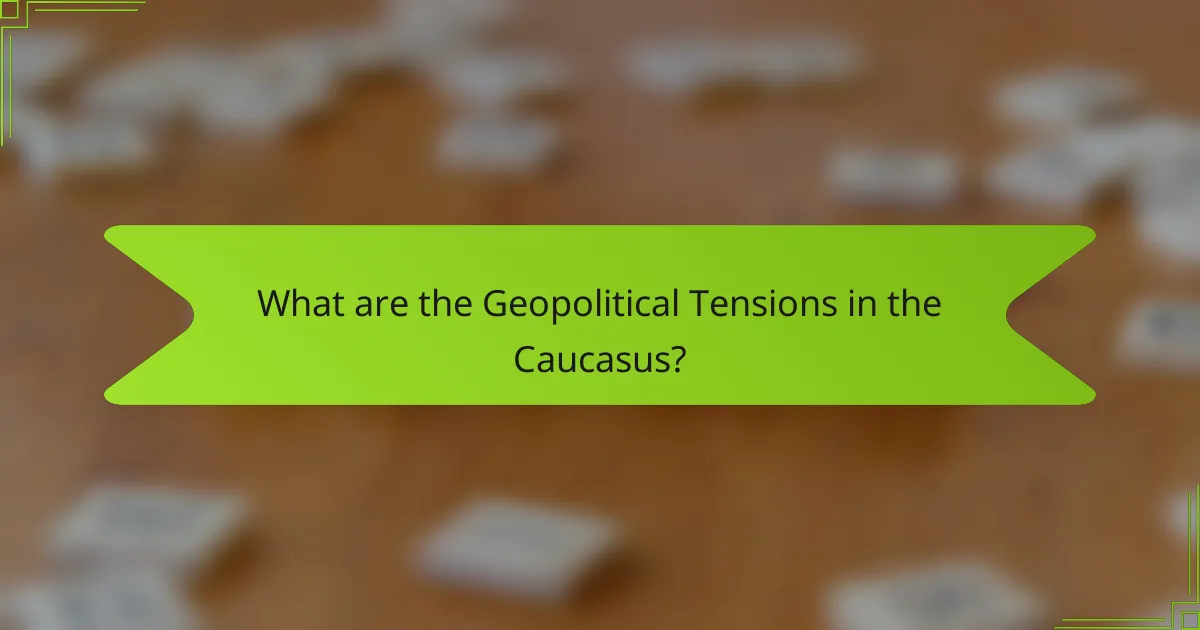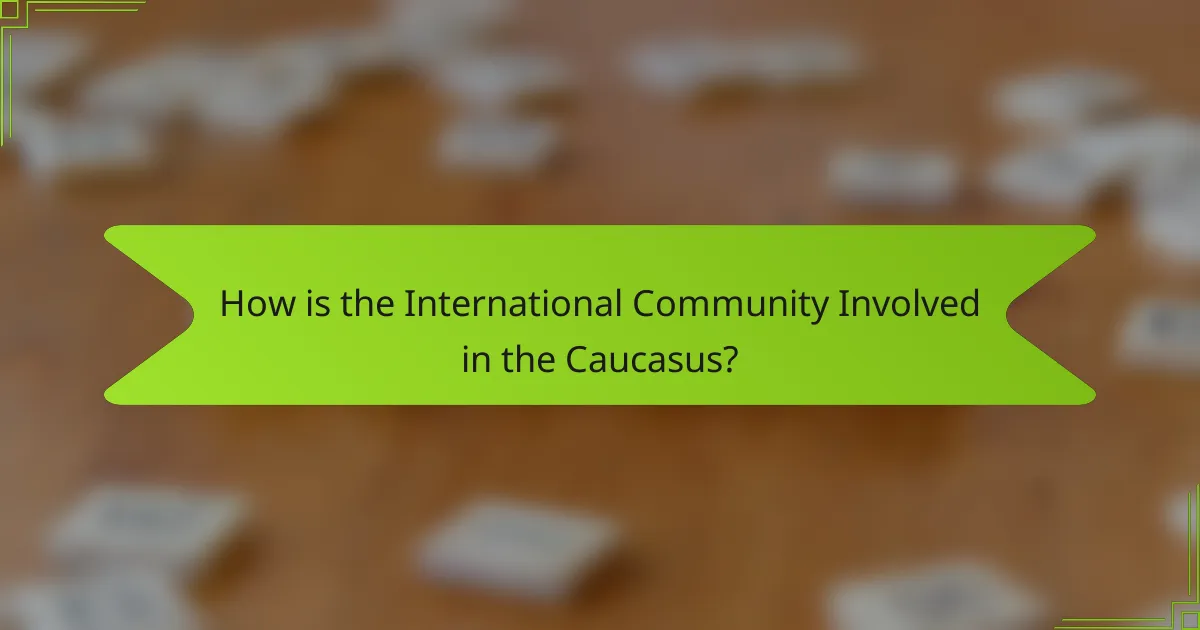The Caucasus region, comprising Armenia, Azerbaijan, and Georgia, is characterized by complex geopolitical tensions stemming from territorial disputes, ethnic conflicts, and historical grievances. A prominent issue is the Nagorno-Karabakh conflict, a long-standing dispute between Armenia and Azerbaijan with roots in the Soviet era, leading to multiple wars and ongoing contestation over sovereignty. The involvement of external powers, particularly Russia and Western nations like the U.S. and EU, adds layers of complexity to the situation, as these entities engage in diplomatic efforts, peacekeeping missions, and economic development initiatives. The article will explore the historical context of these conflicts, current dynamics, and the role of international organizations in promoting stability and cooperation in the Caucasus.

What are the Geopolitical Tensions in the Caucasus?
Geopolitical tensions in the Caucasus arise from territorial disputes, ethnic conflicts, and historical grievances. The region includes countries like Armenia, Azerbaijan, and Georgia. A significant source of tension is the Nagorno-Karabakh conflict between Armenia and Azerbaijan. This dispute has roots in the Soviet era and has led to multiple wars. Control over the region remains contested, with both countries claiming sovereignty. Additionally, Russia’s influence complicates the dynamics, as it supports Armenia while maintaining ties with Azerbaijan. Western nations, particularly the U.S. and EU, also engage in the region, seeking stability and energy routes. These factors contribute to ongoing instability and potential for conflict in the Caucasus.
How did historical events shape the current geopolitical landscape in the Caucasus?
Historical events significantly shaped the current geopolitical landscape in the Caucasus. The collapse of the Soviet Union in 1991 led to the emergence of independent states such as Armenia, Azerbaijan, and Georgia. This independence sparked territorial conflicts, notably the Nagorno-Karabakh conflict between Armenia and Azerbaijan, which continues to influence regional tensions. The Chechen Wars in the 1990s further destabilized the area, affecting Russia’s influence and control over its southern borders. Additionally, the 2008 Russia-Georgia war over South Ossetia and Abkhazia highlighted ongoing ethnic and political disputes. The region’s strategic location, rich energy resources, and diverse ethnic composition make it a focal point for international interests. Consequently, historical grievances and conflicts continue to drive contemporary geopolitical dynamics in the Caucasus.
What key historical conflicts have influenced the region?
The key historical conflicts that have influenced the Caucasus region include the Russo-Turkish Wars, the Caucasian War, and the Nagorno-Karabakh conflict. The Russo-Turkish Wars occurred between the 17th and 20th centuries, impacting territorial boundaries and power dynamics. The Caucasian War lasted from 1817 to 1864, leading to significant Russian expansion and the subjugation of indigenous peoples. The Nagorno-Karabakh conflict began in the 1980s, centered around territorial disputes between Armenia and Azerbaijan. Each of these conflicts has shaped national identities and geopolitical relations in the region. Historical events have fostered deep-seated animosities and alliances that persist today.
How have colonial and post-colonial dynamics affected the Caucasus?
Colonial and post-colonial dynamics have significantly impacted the Caucasus region. The region experienced intense colonial rule, primarily under Russian and Ottoman empires. This colonial legacy established ethnic divisions and territorial disputes. Post-colonial dynamics continued to shape national identities and conflicts. The dissolution of the Soviet Union in 1991 led to renewed tensions among ethnic groups. Conflicts such as the Nagorno-Karabakh war exemplify these tensions. Additionally, external powers have influenced the geopolitical landscape. The Caucasus remains a contested area due to its strategic location and diverse populations.
What are the main current conflicts in the Caucasus?
The main current conflicts in the Caucasus include the Nagorno-Karabakh dispute and tensions in Georgia. The Nagorno-Karabakh conflict involves Armenia and Azerbaijan over territorial claims. This conflict reignited in 2020, leading to significant military clashes. The 2020 ceasefire was brokered by Russia, but tensions remain high.
In Georgia, there are ongoing issues related to the regions of Abkhazia and South Ossetia. Both regions declared independence after the collapse of the Soviet Union. Russia recognized their independence in 2008, leading to strained relations with Georgia. These conflicts contribute to the complex geopolitical landscape in the Caucasus.
What are the causes of the Nagorno-Karabakh conflict?
The Nagorno-Karabakh conflict is primarily caused by ethnic tensions between Armenians and Azerbaijanis. The region has a majority ethnic Armenian population, leading to disputes over territorial claims. Historical grievances date back to the early 20th century. In 1923, the Soviet Union established the Nagorno-Karabakh Autonomous Oblast within Azerbaijan. Following the Soviet Union’s collapse in the late 1980s, tensions escalated into armed conflict. A war between Armenia and Azerbaijan occurred from 1988 to 1994, resulting in Armenian control over the region. The lack of a formal peace agreement has perpetuated ongoing hostilities. External influences, including support from regional powers, have also intensified the conflict.
How do ethnic tensions contribute to ongoing disputes?
Ethnic tensions significantly contribute to ongoing disputes by fueling mistrust and hostility between groups. These tensions often arise from historical grievances, cultural differences, and competition for resources. In the Caucasus region, ethnic groups have long histories of conflict, which exacerbate current disputes. For example, the Nagorno-Karabakh conflict is rooted in ethnic tensions between Armenians and Azerbaijanis. Such animosities can lead to violence, as seen in various flare-ups over territory and autonomy. Additionally, external influences can intensify these tensions, as neighboring countries may exploit ethnic divisions for political gain. The result is a cycle of conflict that is difficult to resolve.
What role do territorial claims play in the current conflicts?
Territorial claims are central to the current conflicts in the Caucasus. These claims often stem from historical grievances and ethnic tensions. For example, the Nagorno-Karabakh region is claimed by both Armenia and Azerbaijan. This dispute has led to multiple armed conflicts over the years. The territorial claims fuel nationalistic sentiments in both countries. Each side views the land as integral to its national identity. The presence of ethnic minorities complicates these claims further. International involvement often exacerbates tensions rather than resolving them. Thus, territorial claims remain a key driver of conflict in this region.
What are the implications of these tensions for regional stability?
The implications of these tensions for regional stability are significant and multifaceted. Increased tensions often lead to military escalations, which can destabilize neighboring countries. For instance, conflicts in the Caucasus have historically resulted in border disputes and refugee crises. These tensions also hinder economic cooperation and development in the region. Trade routes may become insecure, impacting regional economies. Furthermore, external powers may intervene, complicating the geopolitical landscape. This can lead to a cycle of violence and retaliation, further destabilizing the area. Overall, unresolved tensions pose a persistent threat to peace and security in the Caucasus.
How do geopolitical tensions affect neighboring countries?
Geopolitical tensions significantly impact neighboring countries by altering their security dynamics and economic stability. Neighboring nations often experience increased military readiness due to perceived threats. For example, during the Russia-Georgia war in 2008, neighboring countries heightened their defense postures. Economic consequences also arise, as tensions can disrupt trade routes and investment flows. The blockade of trade routes during conflicts, like the ongoing tensions in Armenia and Azerbaijan, illustrates this point. Additionally, geopolitical tensions can lead to refugee crises, as people flee conflict zones, placing strain on neighboring countries’ resources. Historical patterns show that prolonged tensions can result in long-term diplomatic rifts, affecting regional cooperation. Thus, geopolitical tensions create a ripple effect that influences security, economy, and social stability in neighboring countries.
What are the economic impacts of conflicts in the Caucasus?
Conflicts in the Caucasus have significant economic impacts. These conflicts disrupt trade routes and reduce foreign investment. Infrastructure damage leads to increased costs for reconstruction. Unemployment rates rise due to instability, limiting economic growth. Regional economies suffer from decreased tourism and agricultural productivity. According to the World Bank, the 2020 Nagorno-Karabakh conflict resulted in a GDP decline of up to 10% in affected areas. Additionally, displaced populations strain local economies and resources. Overall, the economic consequences are profound and long-lasting.

How is the International Community Involved in the Caucasus?
The international community is involved in the Caucasus through diplomatic efforts, peacekeeping missions, and economic assistance. Various organizations, including the United Nations and the European Union, facilitate dialogue between conflicting parties. The OSCE (Organization for Security and Co-operation in Europe) has been active in mediating disputes in the region. Additionally, the NATO partnership aims to enhance security cooperation. Humanitarian aid from international NGOs supports displaced populations affected by conflicts. The international community monitors human rights situations in the Caucasus to promote stability. Countries like the United States and Russia influence regional dynamics through their foreign policies. Economic investments from foreign entities aim to foster development and reduce tensions.
What roles do major powers play in the region?
Major powers influence the Caucasus region through diplomatic, military, and economic engagement. Russia maintains significant military presence and supports separatist movements in areas like Abkhazia and South Ossetia. The United States promotes democracy and stability through various initiatives and partnerships. Turkey plays a crucial role by providing military support to Azerbaijan, especially during conflicts with Armenia. Iran seeks to expand its influence by fostering economic ties with Armenia and opposing Western presence. These powers often engage in strategic alliances that shape regional dynamics and conflict resolution efforts. For instance, the 2020 Nagorno-Karabakh conflict highlighted the involvement of Russia and Turkey in mediating outcomes.
How does Russia influence geopolitical tensions in the Caucasus?
Russia influences geopolitical tensions in the Caucasus through military presence and political alliances. It maintains military bases in Armenia and South Ossetia. This presence allows Russia to project power in the region. Additionally, Russia supports separatist movements in Abkhazia and South Ossetia. This support exacerbates conflicts with Georgia. Russia also engages in diplomatic negotiations, often positioning itself as a mediator. However, its role is frequently viewed with suspicion by neighboring countries. Historical conflicts have solidified Russia’s influence, as seen in the 2008 war with Georgia. Thus, Russia’s actions shape the geopolitical landscape of the Caucasus significantly.
What is the involvement of the European Union in the region?
The European Union is actively involved in the Caucasus region through diplomatic efforts and economic support. It promotes stability and conflict resolution among the countries in the area. The EU has established the Eastern Partnership initiative to strengthen ties with Armenia, Azerbaijan, and Georgia. This initiative includes political association and economic integration. The EU also participates in peacekeeping missions and monitoring operations, such as the European Union Monitoring Mission in Georgia. Additionally, the EU provides financial assistance for development projects aimed at fostering economic growth and governance reforms. The EU’s involvement is crucial for promoting peace and stability in a region marked by historical conflicts.
What international organizations are active in the Caucasus?
The international organizations active in the Caucasus include the United Nations (UN), the Organization for Security and Co-operation in Europe (OSCE), and the European Union (EU). The UN engages in peacekeeping and humanitarian efforts in the region. The OSCE works on conflict prevention and resolution, particularly in areas like Nagorno-Karabakh. The EU provides financial assistance and promotes democratic reforms through its Eastern Partnership program. Additionally, the North Atlantic Treaty Organization (NATO) collaborates with partner countries in the Caucasus for security cooperation. These organizations play crucial roles in addressing the geopolitical tensions and conflicts in the region.
How does NATO engage with the Caucasus countries?
NATO engages with the Caucasus countries through partnerships and cooperative programs. These initiatives include the Partnership for Peace program, which aims to enhance military cooperation. NATO conducts joint exercises and training missions with the armed forces of Georgia and Azerbaijan. The alliance also provides political support and military training to these nations. NATO’s involvement is part of its broader strategy to promote stability in the region. The 2008 NATO Bucharest Summit reaffirmed support for Georgia’s and Ukraine’s aspirations for membership. NATO maintains a presence in the region through various diplomatic channels. This engagement is crucial for addressing security challenges posed by regional conflicts.
What humanitarian efforts are being made by the UN in the region?
The UN is actively involved in humanitarian efforts in the Caucasus region. It provides emergency relief to displaced populations affected by ongoing conflicts. The UN also facilitates access to essential services, including healthcare and education. Food assistance programs are implemented to combat hunger among vulnerable communities. The organization works with local governments to promote peace and stability. Additionally, UN agencies coordinate with NGOs to ensure efficient delivery of aid. Recent reports indicate ongoing support for rehabilitation and reconstruction projects. These efforts aim to address the long-term needs of affected populations in the region.

What are the Future Prospects for the Caucasus?
The future prospects for the Caucasus are influenced by ongoing geopolitical tensions and regional dynamics. The region faces challenges from unresolved conflicts, particularly in Nagorno-Karabakh. Economic cooperation among Caucasian states could foster stability. The involvement of external powers like Russia, Turkey, and the European Union shapes the political landscape. Infrastructure projects, such as transportation corridors, may enhance connectivity and economic growth. Additionally, energy resources play a crucial role in attracting investment. However, ethnic and territorial disputes remain significant obstacles. Overall, the future of the Caucasus hinges on diplomatic efforts and regional cooperation.
What potential solutions exist for resolving conflicts in the Caucasus?
Potential solutions for resolving conflicts in the Caucasus include diplomatic negotiations, peacekeeping missions, and economic cooperation initiatives. Diplomatic negotiations can facilitate dialogue between conflicting parties. For instance, the Organization for Security and Co-operation in Europe (OSCE) has mediated discussions in the region. Peacekeeping missions can help maintain stability and protect civilians. The presence of international peacekeepers, such as those from Russia or the UN, can deter violence. Economic cooperation initiatives can foster interdependence and reduce hostilities. Joint projects in energy, trade, and infrastructure can create shared interests. Historical examples show that these methods can lead to long-term resolutions. The 2008 ceasefire agreement between Russia and Georgia illustrates the potential for negotiated peace. Therefore, a combination of these approaches may provide a pathway to lasting stability in the Caucasus.
How can diplomatic efforts facilitate peace in the region?
Diplomatic efforts can facilitate peace in the region by fostering dialogue among conflicting parties. These efforts often involve negotiations to address underlying issues. Mediation by neutral third parties can help build trust. Establishing communication channels reduces misunderstandings. Diplomatic initiatives can lead to ceasefires and conflict resolution agreements. Historical examples show that diplomacy has successfully resolved disputes. The Minsk Group’s involvement in the Nagorno-Karabakh conflict illustrates this. Effective diplomacy promotes long-term stability and cooperation among nations.
What role does economic cooperation play in conflict resolution?
Economic cooperation plays a significant role in conflict resolution by fostering interdependence among conflicting parties. This interdependence can reduce tensions and create incentives for peaceful negotiations. For instance, joint economic projects can promote collaboration and trust between nations. Historical examples include the European Union’s establishment, which helped to resolve conflicts in post-World War II Europe through economic integration. Research indicates that economic ties can lead to decreased likelihood of conflict, as seen in the trade relationships between countries like China and its neighbors. Additionally, shared economic interests often motivate parties to seek diplomatic solutions rather than resorting to violence.
What can be learned from the geopolitical tensions in the Caucasus?
Geopolitical tensions in the Caucasus reveal the complexities of ethnic conflicts and territorial disputes. These tensions often stem from historical grievances and colonial legacies. For instance, the Nagorno-Karabakh conflict between Armenia and Azerbaijan highlights the impact of nationalism. International involvement, such as Russia’s role, demonstrates the influence of external powers in regional stability. Additionally, energy resources in the region play a critical role in shaping alliances and conflicts. Understanding these dynamics is essential for predicting future developments. The Caucasus serves as a microcosm of broader geopolitical trends in Eurasia.
How can other regions apply lessons from the Caucasus experience?
Other regions can apply lessons from the Caucasus experience by studying conflict resolution strategies. The Caucasus has a history of ethnic tensions and territorial disputes. Effective dialogue and negotiation have been pivotal in some areas. For instance, the role of international mediators has helped de-escalate conflicts. Regions facing similar issues can benefit from these mediation practices. Additionally, understanding the importance of local governance in conflict management is crucial. The Caucasus experience highlights the need for inclusive political frameworks. By fostering community engagement, other regions can enhance stability. Historical case studies from the Caucasus provide valuable insights into managing complex geopolitical dynamics.
What strategies can be implemented to promote stability in conflict-prone areas?
Implementing strategies to promote stability in conflict-prone areas involves several key approaches. First, fostering dialogue among conflicting parties is essential. Mediation efforts can help facilitate communication and understanding. Second, establishing economic development programs can address underlying grievances. Economic stability reduces the likelihood of conflict resurgence. Third, investing in education and community-building initiatives promotes social cohesion. Educated populations are less susceptible to extremist ideologies. Fourth, strengthening local governance enhances trust in institutions. Effective governance can mitigate tensions and provide essential services. Lastly, international support and cooperation are crucial. Engaging global organizations can provide resources and expertise. Historical examples show that these strategies can lead to long-term peace and stability. For instance, the success of the Dayton Agreement in Bosnia illustrates the importance of comprehensive peace processes.
The main entity of this article is the geopolitical tensions in the Caucasus, which are shaped by historical conflicts, ethnic disputes, and external influences. The article provides an overview of key territorial disputes, particularly the Nagorno-Karabakh conflict between Armenia and Azerbaijan, and examines the historical events that have contributed to the current geopolitical landscape. It also discusses the roles of major powers, including Russia and the European Union, in the region, as well as the implications of these tensions for regional stability and economic impacts. Finally, the article explores potential solutions for conflict resolution and highlights the lessons that can be learned from the Caucasus experience in managing geopolitical dynamics.